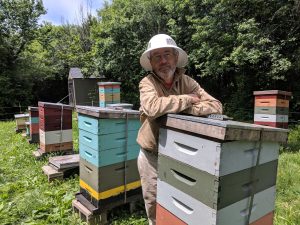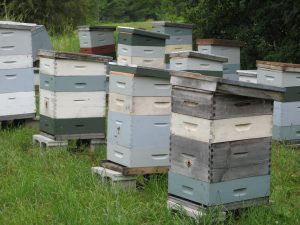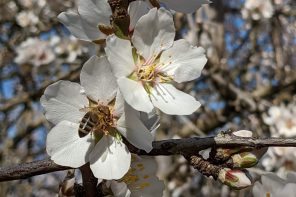Click Here if you listened. We’d love to know what you think. There is even a spot for feedback!
Read along below!

For the Love of Bees
Some of the ways backyard beekeepers benefit commercial operations and vice-versa
By: Ross Conrad
The beekeeping community is generally divided into two primary categories. There are commercial entrepreneurs and small-scale part-time backyard beekeeping enthusiasts. Commercial operators can be further broken down into full-time and part-time sideliners. It turns out that while all these groups all tend to have very different underlying motivations, they all share many similar types of knowledge and practices, and mutually support one another.

The Australian beekeepers studied rely heavily on meetings, events and conferences to keep up on the latest research. However, while knowledgeable speakers are valued, a lot of information exchanges take place between programs, out in the hallways where beekeepers share ideas and management practices.
The similarities among these different groups and how they interact with each other is the subject of a 2023 paper authored by Kirsten Martinus, associate professor of the School of Social Sciences at the University of Western Australia. The paper titled, ‘It’s a love interest’—Enthusiasts and regional industry cultures of practice, explores some of the similarities, differences and relationships between commercial and backyard beekeepers. While this study focused on a specific region of beekeepers in Western Australia, the information documented can be of benefit to beekeepers the world over due to the universality of the issues beekeepers face globally.
Dr. Martinus’ work suggests that commercial beekeepers and backyard honey bee enthusiasts both stand to benefit by cooperating and working together to share knowledge and information. As Dr. Martinus notes, “the findings point to the importance of informal non-firm actors in place-specific problem solving through a culture of exchange and mutual endeavor. This suggests that developing a regional industry culture of practice and entrepreneurship may support collaborations between hobbyists or enthusiasts and local business counterparts, which in turn will enhance regional competitiveness, identity and placemaking.” To put it simply, backyard beekeepers and commercial beekeepers can, and often do, support and benefit one another.
The Australian beekeepers studied shared a sense of local beekeeping tradition and long-time commitment, given that the majority use the Langstroth hive as opposed to alternative hive designs. For commercial operators, this was partly because other methods are not seen as commercially viable, due to the large capital investment in equipment required to change. It is also because some hive designs were not seen as authentic, as in the case of the Flow Hive.

Whether it’s a few hives in the backyard or thousands, beekeepers of all sizes love their bees.
Although much of the technology and management used in beekeeping is similar globally, this study acknowledges the importance of generalized regional variations depending on local weather, climate and whether colonies are located in urban, farmland or rural settings. ‘It’s a love interest’ notes that beekeeping “is an activity that requires both scientific and practical knowledge on bee behaviors, husbandry and hive care, as well as knowledge that is deeply embedded in ‘place’ such as weather, flowering times and places, and state and local laws around bee management and ownership.”
Commercial beekeepers are widely understood to be “regional assets” or “resources” that can help local beekeeping groups and shape new industry paths. Meanwhile backyard beekeepers have the luxury of being able to experiment and explore novel beekeeping techniques since their apicultural activities are decoupled from their livelihoods. The lines between commercial and backyard beekeepers often gets blurred however, such as when commercial operators retire and transition to part-time, when professionals mentor backyard beekeepers, and when commercial beekeepers receive fresh insights through informal exchanges with part-time enthusiasts.
A relatively low conversion rate from backyard to commercial beekeeper was observed. A backyard beekeeper’s commercial transition depends not only on “innovation but on willingness to upscale operations after acquiring skills and knowledge.” Some of the greatest barriers to commercializing a backyard operation are related to finances, liability and beekeeping competence. My own observation is that many commercial beekeepers get their start working for a commercial beekeeping operation. This allows them to get paid while they build the skill level they need to be successful on their own.
We beekeepers are free to practice an ever growing array of different types of beekeeping management with hives of various styles, different types of bees, and hard chemical, soft chemical or non-chemical treatment options just to name a few. We also adopt a wide variety of underlying motivations for engaging in beekeeping activities. Backyard beekeepers may enjoy the intellectual, educational and social aspects of beekeeping, while others may simply be looking to provide pollination for their gardens. Commercial beekeepers are primarily concerned with earning a living, managing colonies efficiently and reducing the physicality of their bee work. They were found to primarily work collaboratively on issues that address profitability and business viability.
The study found that the “novel and diverse local and technical know-how, personal experience, scientific and technical skills and occupational backgrounds, and social and work networks” that backyard beekeepers bring to their craft may offer commercial beekeepers an “external and complementary knowledge source”. The value of this contribution to the industry however, is not widely recognized. As one operator is quoted as saying, those in commercial beekeeping “think hobbyists don’t know anything, and hobbyists know they don’t want to do it on a big scale.”
The backyard beekeeping enthusiast plays an important role in improving community and social acceptance of beekeeping and helping to raise awareness of the importance of bee decline. They are more likely to get involved in honey bee related activities within their communities and this improves the industry’s profile overall by increasing social awareness of the industry and the plight of the bees. Their community engagement helps to strengthen society’s connection to beekeeping and the environment. This in turn can also help change local policies and laws that relate to beekeeping activities.
Dr. Martinus found that backyard beekeepers are generally less knowledgeable about bees and beekeeping than commercial operators, which may be why they are more willing to spend more time seeking and sharing knowledge. While backyard beekeepers tend to be quick to share know-how and experiences, commercial operators were found to generally be more protective of industry secrets and information.

Historically, a beekeepers commitment and profitability have been judged by asking questions like “How many hives do you run?” and “How long have you been keeping bees?” In the age of varroa and neonicotinoid pesticides, a new question is often used to quickly evaluate ones seriousness as a beekeeper: “What percentage of your colonies did you lose this Winter/year?”
Enthusiasts viewed the sharing of ideas and experiences as a way to enhance the beekeeping community. This process is facilitated through formal activities such as bee club and association meetings, classes and workshops and informally through mentorships. All this is in addition to more open access forms of accessing information through blogs, extension service and scientific websites, association or government newsletters and beekeeping journals and periodicals.
The primary focus of backyard beekeepers on basic beekeeping information makes sense given the steep learning curve necessary to get up to speed in bee culture. Less experienced beekeepers tend to be highly dependent on the knowledge of seasoned beekeepers and often adopt a “belief in the person”. The study notes that most enthusiasts felt “they received more information than they passed on, and that information was ‘unlocked’ through a gradual process of increased community status and credibility as they gained knowledge, experience and skill.” This process also impacts how a beekeeper is viewed within the wider beekeeping social network ‘because everyone knows everyone’.
All too often we beekeepers can be judgmental and seek to establish an ego driven pecking order and try to improve our status amongst our peers. A quick and dirty method many of the Australian beekeepers studied used to evaluate another’s commitment and profitability as a beekeeper is by assessing the number of years keeping bees (part-time) or the number of hives one manages (commercial). Of course, the use of such proxies to judge another’s seriousness as a beekeeper is fraught with error and can often be wildly mistaken, but they are commonly used nonetheless.
While keeping bees typically is an isolated activity, learning how to keep bees has a strong social component. This study documented the beekeeping community’s openness and willingness to share management techniques and has built into its ecosystem various opportunities for enthusiast-professional interactions at meetings, conferences and events, all of which serve to strengthen the overall beekeeping community. According to Dr. Martinus, “…hobbyists can be conceived as ‘apprentices’ engaged in legitimate peripheral participation where learning and mastery occurs through participation” in beekeeping. Furthermore, “…interactions between individuals produce a shared identity, related to both individual skill acquisition and an individuals’ existence within a certain context of and having competencies within the group.” Additionally, “…learning of practice then does not always occur in the same locality or in organized forms (e.g. work teams), but also informally through shared experience, passion or expertise and can occur across space and may include professionals, semi-professionals and hobbyists.”
The sharing of beekeeping information and techniques is facilitated by the fact that we are all working with the same insects and have a similar base of knowledge. There is a wide network of both formal and informal opportunities where individuals can connect with each other, allowing beekeepers to share and obtain meaning through the active process of learning by tackling similar problems and issues. Knowledge sharing between non-commercial and commercial groups allows for the exchange of perspectives which can be critical to figuring out what will work in one’s specific situation.
Dr. Martinus summarizes her work this way: “This research has found extensive direct and indirect interactions between hobbyists and operators, which have enhanced the value of hobbyist activities and have become channels for industry and community appropriation. As firm external knowledge sources, hobbyists did not fit current understandings of how user innovators might support industry. This finding perhaps reflects the low-tech character of beekeeping, which allows hobbyists to engage in non-profit markets alongside commercial ones. Hobbyists were both market competitors forcing operators into niche markets focused on tourist, mono-floral, high-value honey and collaborators involved in adapting global scientific or practical knowledge to the Western Australian context given the commercial focus on small process or technical/mechanical changes to improve productivity. Hobbyist activities were also of wider societal benefit, lifting community science levels, counteracting climate change, and changing industry’s operational context by changing policy and shifting societal images of bees and beekeeping.”
According to Dr. Martinus, the results of her study can be used to strengthen the beekeeping community in a couple ways: First is through “Better support for interactions between hobbyists and industry … for example funding or in-kind support to grow mentoring or internship schemes. These appear critical in the transfer of practice between the groups; it also provides a source of low cost labor for industry, and encourages responsible beekeeping amongst new hobbyist beekeepers as a means to address biosecurity threats.”
The second way her findings can strengthen the beekeeping industry is through “more appropriate policy in local governments – local laws on domestic keeping of animals particularly in urban areas, does often not adequately address beekeeping. This would recognize the importance of hobbyist beekeepers in the community (and bees in the environment). Related to this – the enactment of laws around urban beekeeping is often ad hoc, as local officials often do not understand bee behaviors and may be inclined to take an overly-cautious approach towards bees in urban areas in dispute resolution.”
Despite the huge diversity in practices and motivations among beekeepers, we all are dealing with many of the same issues from how to handle swarms, deal with foraging dearths, diseases, pests, queen issues, honey harvesting, timing of nectar flows, pesticide poisoning, etc. Ultimately, we are all in the same boat. By valuing and capitalizing on our differences rather than judging or denigrating them, we stand to create a stronger, more resilient beekeeping industry. A valuable lesson that is applicable not only to our industry, but many other areas of our lives as well.








